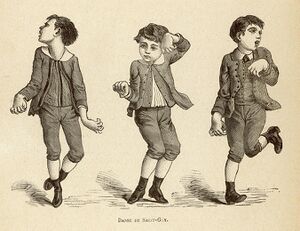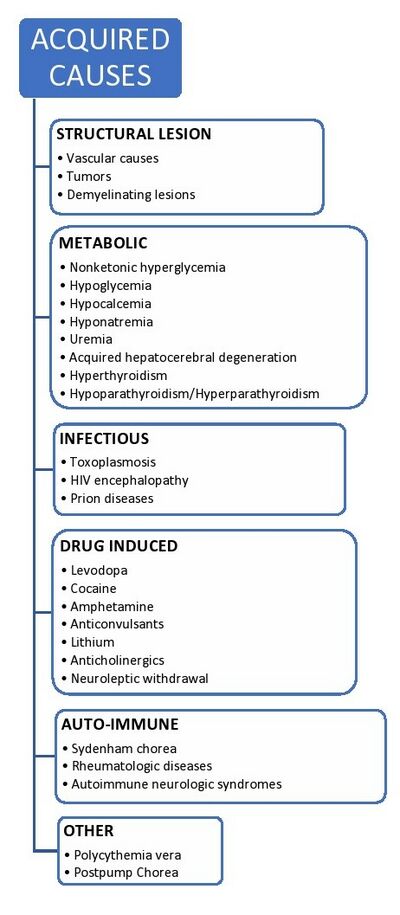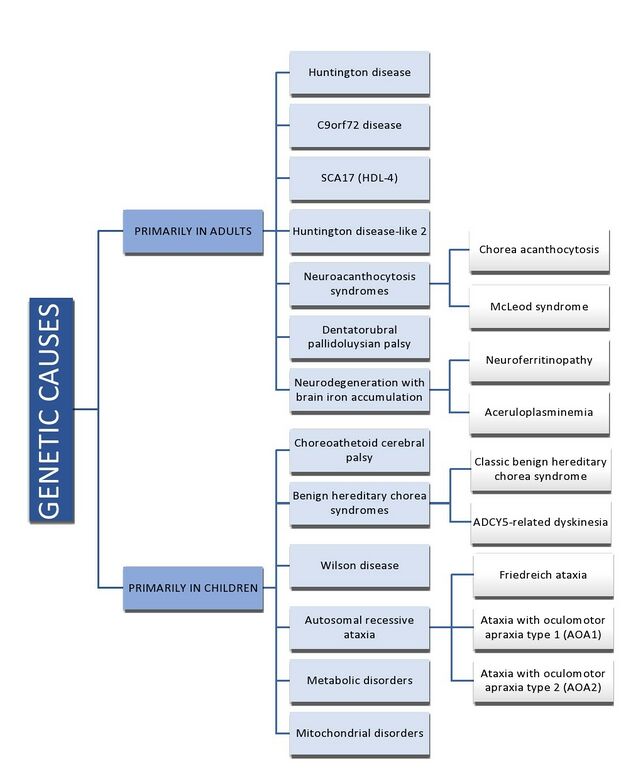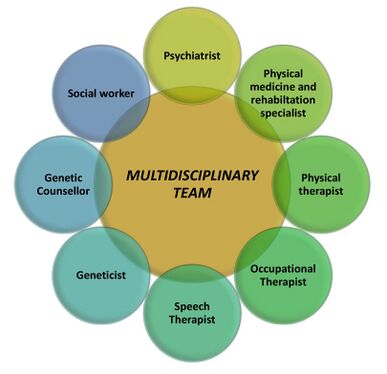Chorea: Difference between revisions
No edit summary |
No edit summary |
||
| (21 intermediate revisions by 3 users not shown) | |||
| Line 1: | Line 1: | ||
<div class="editorbox"> '''Original Editor '''- [[User:Muskan Rastogi|Muskan Rastogi]] '''Top Contributors''' - {{Special:Contributors/{{FULLPAGENAME}}}}</div> | <div class="editorbox"> '''Original Editor '''- [[User:Muskan Rastogi|Muskan Rastogi]] '''Top Contributors''' - {{Special:Contributors/{{FULLPAGENAME}}}}</div> | ||
< | ==Introduction== | ||
[[File:Chorea.jpeg|thumb|Rheumatic chorea]] | |||
Chorea is defined as "a state of excessive, spontaneous movements, irregularly timed, non-repetitive, randomly distributed and abrupt in character. These movements may vary in severity from restlessness with mild intermittent exaggeration of gesture and expression, fidgeting movements of the hands, unstable dance-like gait to a continuous flow of disabling, violent movements."<ref name=":1">Merical B, Sánchez-Manso JC. Chorea. Available: https://www.ncbi.nlm.nih.gov/books/NBK430923/#!po=15.0000<nowiki/>(accessed 19.9.2022)</ref> | |||
# The word Chorea has Greek origins meaning "to dance". It has a dance-like appearance due to the random and flowing quality of the movement. | |||
# Chorea is a type of [[Hyperkinetic Movement Disorder|hyperkinetic movement disorder]]. | |||
# The involuntary movements flow from one body area to another which cannot be predicted beforehand. | |||
== Etiology == | |||
Chorea traditionally is described in Huntington disease, however other disorders that can lead to chorea, for example: Spinocerebellar [[ataxia]] subtypes; [[Wilson's Disease|Wilson disease]]; Sydenham chorea, and structural disease of the basal ganglia. Generally, the root of the pathology is in the [[Basal Ganglia|basal ganglia]].<ref name=":1" /> | |||
They are predominantly of 2 types<ref name=":0">Termsarasab P. [https://journals.lww.com/continuum/Abstract/2019/08000/Chorea.9.aspx Chorea]. CONTINUUM: Lifelong Learning in Neurology. 2019 Aug 1;25(4):1001-35.</ref> | |||
* Acquired Causes | |||
* Genetic Causes | |||
[[File:Acquired causes chorea.jpg|thumb|915x915px|Acquired Causes of Chorea|alt=|center]] | |||
[[File:Genetic causes of chorea.jpg|center|thumb|779x779px|Genetic Causes of Chorea]] | |||
== Phenomenological Features == | |||
* Randomness | |||
* Flowing Quality | |||
* Parakinesia: Patients blend their chorea-induced movements with their own normal movements. | |||
* Motor impersistence: the patient is unable to perform sustained motor activities. | |||
* Ballism: Variant of chorea which shows large-amplitude flinging movements involving proximal extremities. | |||
* Athetosis: Slow writhing movements involving distal limbs sometimes may be facing. | |||
* Varying velocity of movements: quick velocity and low-amplitude movements accompanied by jerks.<ref name=":0" /> | |||
== | {{#ev:youtube|RxWEilu-Mf4}} | ||
This video displays the dance-like movements performed by a patient.<ref>neurosigns.org. Chorea. Available from https://www.youtube.com/watch?v=RxWEilu-Mf4&ab_channel=neurosigns.org</ref> | |||
== Diagnosis == | |||
The phenomenological features mentioned above are observed to make a diagnosis of chorea. | |||
=== Differential Diagnosis === | |||
Specific diagnosis can be made on the basis of symptoms/clinical features experienced by the patient.<ref name=":0" />Differential diagnoses include: | |||
* [https://www.physio-pedia.com/Huntington_Disease Huntington disease] | |||
* [[Lyme Disease|Lyme disease]] | |||
* [[Multiple System Atrophy|Multiple system atrophy]] | |||
* Neuroacanthocytosis | |||
* Pediatric torticollis surgery | |||
* [[Ramsay Hunt Syndrome|Ramsay Hunt]] syndrome | |||
* Striatonigral degeneration | |||
* Tourette syndrome | |||
* Viral [[encephalitis]]<ref name=":1" /> | |||
== Multimodal Management == | |||
[[File:Mutimodal management chorea.jpg|right|frameless|387x387px]] | |||
Chorea requires a Multidisciplinary Approach to be treated.<ref>Feinstein E, Walker R. [https://link.springer.com/article/10.1007/s11940-018-0529-y An update on the treatment of chorea. Current Treatment Options in Neurology]. 2018 Oct;20(10):1-5.</ref> | |||
The team includes: | |||
* Psychiatrist | |||
* Physical medicine and Rehabilitation Specialist | |||
* Physical therapist | |||
* Occupational therapist | |||
* Speech therapists | |||
* Geneticist | |||
* Genetic Counselor | |||
* Social worker | |||
=== Medical Management === | |||
There is '''no cure''' for this disease but symptoms can be managed. Importantly an evaluation and creation of a patient's support system is needed. With disease progression, the patient will need specialized care. Nutrition management is important, due to difficulty swallowing.<ref name=":1" /> | |||
1. Dopamine-depleting agents: Tetrabenazine, Deutetrabenazine, Valbenazine. | |||
2. Dopamine D2 receptor-blocking agents: Haloperidol, Clozapine, Olanzapine. | |||
3. Anticonvulsants: Valproic acid, Carbamazepine, Benzodiazepines, Levetiracetam. | |||
4. Anti-glutamatergic agents: Amantadine, Riluzole. | |||
5. Cannabinoids: Nabilone. | |||
6. [[Deep Brain Stimulation]] | |||
== Physiotherapy Management == | |||
The management will be same as of [https://www.physio-pedia.com/Huntington_Disease?utm_source=physiopedia&utm_medium=search&utm_campaign=ongoing_internal#Physiotherapy_Management Huntington's Disease]. | |||
=== Goals of Management === | |||
* [[Gait]] re-education | |||
* [[Balance Training|Balance r]]<nowiki/>[[Balance Training|etraining]] | |||
* [[Falls|Fall]] prevention/management | |||
* [[Aerobic Exercise|Aerobic]] capacity | |||
* Muscle [[Strength and Conditioning|strengthening]] | |||
* [[Wheelchair Assessment|Wheelchair]] prescription and training | |||
* [[Respiratory Muscle Training|Respiratory]] function | |||
* Task-specific reach, grasp, and manipulation. | |||
==References== | ==References== | ||
[[Category:Neurology]] | |||
[[Category:Neurological - Conditions]] | |||
Latest revision as of 12:12, 2 October 2022
Introduction[edit | edit source]
Chorea is defined as "a state of excessive, spontaneous movements, irregularly timed, non-repetitive, randomly distributed and abrupt in character. These movements may vary in severity from restlessness with mild intermittent exaggeration of gesture and expression, fidgeting movements of the hands, unstable dance-like gait to a continuous flow of disabling, violent movements."[1]
- The word Chorea has Greek origins meaning "to dance". It has a dance-like appearance due to the random and flowing quality of the movement.
- Chorea is a type of hyperkinetic movement disorder.
- The involuntary movements flow from one body area to another which cannot be predicted beforehand.
Etiology[edit | edit source]
Chorea traditionally is described in Huntington disease, however other disorders that can lead to chorea, for example: Spinocerebellar ataxia subtypes; Wilson disease; Sydenham chorea, and structural disease of the basal ganglia. Generally, the root of the pathology is in the basal ganglia.[1]
They are predominantly of 2 types[2]
- Acquired Causes
- Genetic Causes
Phenomenological Features[edit | edit source]
- Randomness
- Flowing Quality
- Parakinesia: Patients blend their chorea-induced movements with their own normal movements.
- Motor impersistence: the patient is unable to perform sustained motor activities.
- Ballism: Variant of chorea which shows large-amplitude flinging movements involving proximal extremities.
- Athetosis: Slow writhing movements involving distal limbs sometimes may be facing.
- Varying velocity of movements: quick velocity and low-amplitude movements accompanied by jerks.[2]
This video displays the dance-like movements performed by a patient.[3]
Diagnosis[edit | edit source]
The phenomenological features mentioned above are observed to make a diagnosis of chorea.
Differential Diagnosis[edit | edit source]
Specific diagnosis can be made on the basis of symptoms/clinical features experienced by the patient.[2]Differential diagnoses include:
- Huntington disease
- Lyme disease
- Multiple system atrophy
- Neuroacanthocytosis
- Pediatric torticollis surgery
- Ramsay Hunt syndrome
- Striatonigral degeneration
- Tourette syndrome
- Viral encephalitis[1]
Multimodal Management[edit | edit source]
Chorea requires a Multidisciplinary Approach to be treated.[4]
The team includes:
- Psychiatrist
- Physical medicine and Rehabilitation Specialist
- Physical therapist
- Occupational therapist
- Speech therapists
- Geneticist
- Genetic Counselor
- Social worker
Medical Management[edit | edit source]
There is no cure for this disease but symptoms can be managed. Importantly an evaluation and creation of a patient's support system is needed. With disease progression, the patient will need specialized care. Nutrition management is important, due to difficulty swallowing.[1]
1. Dopamine-depleting agents: Tetrabenazine, Deutetrabenazine, Valbenazine.
2. Dopamine D2 receptor-blocking agents: Haloperidol, Clozapine, Olanzapine.
3. Anticonvulsants: Valproic acid, Carbamazepine, Benzodiazepines, Levetiracetam.
4. Anti-glutamatergic agents: Amantadine, Riluzole.
5. Cannabinoids: Nabilone.
Physiotherapy Management[edit | edit source]
The management will be same as of Huntington's Disease.
Goals of Management[edit | edit source]
- Gait re-education
- Balance retraining
- Fall prevention/management
- Aerobic capacity
- Muscle strengthening
- Wheelchair prescription and training
- Respiratory function
- Task-specific reach, grasp, and manipulation.
References[edit | edit source]
- ↑ 1.0 1.1 1.2 1.3 Merical B, Sánchez-Manso JC. Chorea. Available: https://www.ncbi.nlm.nih.gov/books/NBK430923/#!po=15.0000(accessed 19.9.2022)
- ↑ 2.0 2.1 2.2 Termsarasab P. Chorea. CONTINUUM: Lifelong Learning in Neurology. 2019 Aug 1;25(4):1001-35.
- ↑ neurosigns.org. Chorea. Available from https://www.youtube.com/watch?v=RxWEilu-Mf4&ab_channel=neurosigns.org
- ↑ Feinstein E, Walker R. An update on the treatment of chorea. Current Treatment Options in Neurology. 2018 Oct;20(10):1-5.










